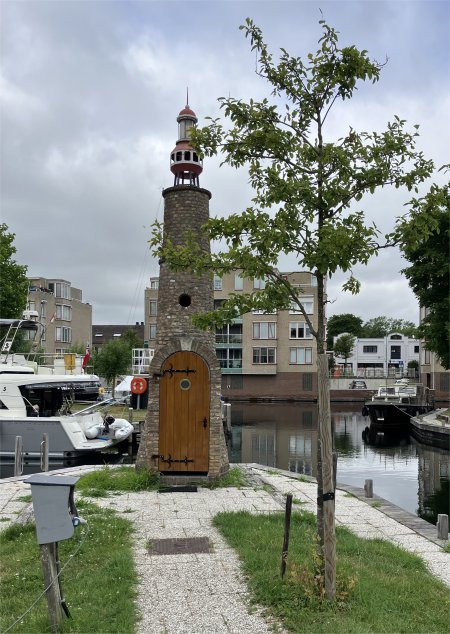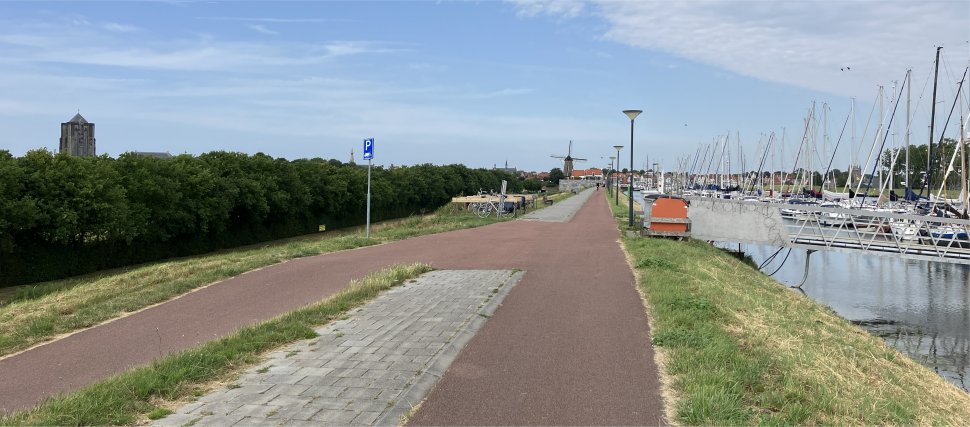 De Werf Lighthouse, the Light is Lit When Someone Uses the Toilet Behind the Door at the Base - Seriously |
At 10am, we were one of eleven vessels all gilling about by the bridge. The bells by the bridge sounded to warn people crossing the bridge that the bridge opening was imminent, and a red light would have been flashing at road-level too. The lights would then turn to red, and the barriers would come down. One clown or learner had decided to drive under a barrier as it was coming down, and managed to just scrape under. However, he could not progress across the bridge since the barrier at the other side was already down. The bridge operator cursed, and had to raise the barriers again in order for the mad driver to escape with his tail between his legs. The whole process had to start over again.
At last, a strung-out convoy was heading along the Havenkanaal, but our passage through the Sluis Goese Sas was not straight forward. The lock operator was keen to cram the now 12 boats into the lock together, which took some time.
Once out in the Oosterschelde it was a straightforward run in a Force 3 up to the bridge at the Schouwen-Duiveland end of the Zeelandbrug. All the delays we had suffered through our journey so far meant that we would be too late for the opening which occurred at 25 mins and 55 mins past the hour. We were some distance off when we spotted the bridge opening and closing. Nevertheless, we were now in good time for the 12:25 opening. We gilled about by the bridge; the only vessel. 12:25 came and went, but the bridge did not open. Perhaps the bridge was never opened for very low numbers of yachts, but that seemed a tad unfair. Half an hour later, there were several yachts around us waiting for the bridge to open. Investigations revealed the bridge opened on 55 mins past the hour only! When it did open, all the yachts raced through despite two yachts coming through from the other direction. The Dutch always need to race in order to be first.
We tootled through and soon found ourselves heading up the Havenkanaal towards Zierikzee. On the pontoon by the restaurant for WSV Zierikzee, we were greeted by a lady who seemed to be running the bar and restaurant plus acting as the harbour master at the same time. "What is your ship's breadth?" she asked.
"3.5m," I replied, "and we'd like a berth for two nights, please," I added. She scanned a clipboard (Rex approves of clipboard scanning), and advised us to berth in a box between 107 and 108. She would come and help us.
The box was not difficult to locate. Berthing was not easy due to the strong tide pushing us sideways. She collared two locals to help us. The first thing we learned from the two men was to take our fenders in. Although Duonita's berth is actually 3.3m, we ask for 3.5m in order to allow for our fenders; we have learned that trick from previous sardine fittings. It soon became apparent that the berth we had been offered was less than 3.5m. We duly lifted our fenders, nudged our way in, and slid our stern lines around the vertical poles attached to the box piling.
"No, no!", shouted the men, "You have to feed your ropes through the rings." What rings we thought.
"Use your boat hooks to pull the rings up from below the water," was the next instruction. I fished up a ring, and Rex managed to pass a stern line through it.
"Put your port fenders out !" was the next instruction barked to us. We complied, as well as trying to get the other stern line through a ring whilst struggling against the tide that was relentlessly pushing us sideways. Then I made my way to the bow, and the two men put our bow lines around bollards on the pontoon and fed them back.
"Move your boat forward 2m," was the next command. I got the bow lines taut, the men were happy and left smiling, uttering, "We charge by the hour." WowWee, were we grateful for their help. In all the years we have been using boxes in Holland, we have never experienced such grief. Indeed, we have visited this marina a few times before and never been asked to feed stern lines through rings. Perhaps we were unlucky trying to berth when the tide was in full spate.
 West Havendijk, Heading Towards Town |
 Den Haas Mill |
Around 1600, a post mill was built on the Bolwerk, which was demolished in 1723. In 1726, the owners of the De Flesse post mill requested permission for a new mill on the site. In 1727, a flour mill, the Korenmolen Den Haas was built. It is a round stone mill with three pairs of grinding stones and a radius of 23.8m. Grinding was carried out regularly until 1953, after which the mill fell into disrepair. In 1984, the municipality of Schouwen-Duiveland became the owner of the mill and it was restored. The mill was put back into use in 1987, and runs almost every Friday when it can be visited.
We were now within the town boundary. Zierikzee is a small town, located on the former island of Schouwen in the province of Zeeland. The conurbation was granted town rights in 1248 and was an independent municipality until 1997. Since the early Middle Ages, Zierikzee was a rich trading town. Its wealth led to the construction of a beautiful port, town hall, mills, church and town walls and gates. One of the many joys of Zierikzee is that itís small and compact with architectural treasures from several different historic periods. Thereís a variety of architectural styles and the historic centre looks like itís been preserved in amber. The town was damaged by the catastrophic North Sea flood of 1953, and received help from the English town of Hatfield. Since then, a friendship has developed between them, and now the two towns are twinned.
 Beers in Havenplein |
We cut through a few side streets into the Havenplein, the central square where we found a suitable small restaurant to enjoy a drink or two and a meal. Whilst there I enjoyed a call with my eldest daughter, Sally, and her son Ralph, who was celebrating his 4th birthday in a splash park. Sally excitably told me about a school she and George had identified for Ralph for the next Autumn term. Meanwhile Rex was at his schoolboy best, trading insults over WhatsApp with friends back in Tollesbury.
On the northern edge of the Havenplein lay the Gasthuiskerk. The Gasthuis or small church was originally the chapel of the guest house, which was founded in the second half of the 14th century and served as a shelter for poor strangers in transit and for the needy sick. Later, insane people were also admitted. The guesthouse was located behind the current church, on Hoge Molenstraat. The chapel was served by its own pastor. The church, like the guest house, was dedicated to the Virgin Mary. After the Reformation, this chapel and church building, like the other properties, were confiscated by the government and given to use by the Walloon Reformed community, which emerged in 1587 and was served by one, later by two, ministers. In 1613, the Walloon congregation, where sermons were preached in French, was allocated a building on Poststraat (until recently part of the Zeeland Music School).
The growing Dutch Reformed congregation had a need for a second church building and the Gasthuiskerk was made available to them. On June 23, 1613, the first sermons were preached in Dutch. The allocation of the Gasthuiskerk was only a partial solution to the need for space. The church was too small to contain the ever-growing crowd of churchgoers. Possibilities were sought to help the municipality find more space. The choice fell on enlarging the Gasthuiskerk. However, magnification brought problems.
The guest house was on the north side and private homes were on the south side. The town council decided to purchase these houses in order to find the necessary space for expansion. It took several more years before all the houses were owned by the town. In 1650, the municipal council ordered the preparation of specifications for the expansion. It was decided to build a stock exchange with a gallery above it. The church therefore received a significant increase in the number of seats. The fair provided the opportunity to trade in an area protected from rain and snow. Close to the harbour and opposite the 'Breede bridge', which served as a place for all kinds of activities, it was an excellent location for traders. In addition, the church became easier to reach. The demolition of the houses took place in 1651. A plan drawn up by the carpenters, Pieter and Bastiaan Vogelaar, was approved and the first stone was laid on Friday, June 3, 1651 (this date can be found on the facade). The gate to the east of the Gasthuiskerk, which formed the entrance to the Gasthuis, was built during this expansion of the Gasthuiskerk in 1651/1652.
In few places in the Netherlands do church and society meet as emphatically as in Zierikzee at the Havenplein. During hot summer days it is wonderfully cool in the fair. There you can enjoy everything that passes by. The Beurs - the Zierikzee residents call it the Beuze - is still a meeting place for many. A nice chat, a lovely walk in the sun, it's all possible here.
 Gasthuiskerk |
